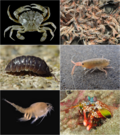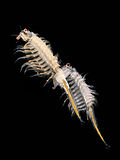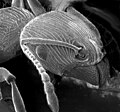genus name Nauplius was published posthumously by Otto Friedrich Müller in 1785 for animals now known to be the larvae of copepods. The nauplius stage (plural:...
22 KB (2,506 words) - 01:26, 4 June 2024
Barnacle (redirect from Cypris larva)
larval stages, the nauplius and the cyprid, before developing into a mature adult. A fertilised egg hatches into a nauplius: a one-eyed larva comprising a head...
49 KB (4,706 words) - 12:32, 5 October 2024
harbor town in Greece Nauplius (larva), a life stage of crustaceans Nauplius (plant), a genus in the family Asteraceae Nauplius, a genus of copepods,...
854 bytes (123 words) - 23:11, 22 June 2023
A larva (/ˈlɑːrvə/; pl.: larvae /ˈlɑːrviː/) is a distinct juvenile form many animals undergo before metamorphosis into their next life stage. Animals...
15 KB (1,378 words) - 09:41, 2 November 2024
Facetotecta (redirect from Y-nauplius)
never been recognised, and the group is known only from its larvae, the "y-nauplius" and "y-cyprid" larvae. They are mostly found in the north Atlantic Ocean...
9 KB (831 words) - 13:00, 12 April 2024
statocysts and sensory bristles. The naupliar eye is a characteristic of the nauplius larva and consists of four cup-shaped ocelli facing in different directions...
30 KB (2,975 words) - 15:09, 22 October 2024
water-breathers with extendable jaws. Crustaceans commonly hatch as tiny nauplius larvae that have only three segments and pairs of appendages. Based on...
131 KB (12,471 words) - 22:01, 31 October 2024
water over sandy, rocky, or muddy substrates. A female Sacculina carcini larva settles on a suitable crab host and crawls across its surface until it finds...
12 KB (1,183 words) - 12:16, 18 February 2024
water-breathers with extendable jaws. Crustaceans commonly hatch as tiny nauplius larvae that have only three segments and pairs of appendages. Insect species...
39 KB (4,846 words) - 18:25, 23 October 2024
depths around 2,000–3,000 metres (6,600–9,800 ft). The egg hatches as a nauplius larva; once this has moulted into a metanauplius, the young animal starts...
40 KB (4,472 words) - 23:02, 17 October 2024
tantulus larvae. The finding of what appears to be a benthic non-feeding nauplius larva suggests that eggs produced by sexual females hatch as nauplii instead...
10 KB (761 words) - 16:01, 5 June 2024
relationships between taxa. Müller demonstrated that crustaceans shared the Nauplius larva, identifying several parasitic species that had not been recognized...
57 KB (6,279 words) - 02:33, 31 October 2024
Rhizocephala (section Nauplius and cypris larvae)
offspring also hatch directly into fully developed cyprids instead of nauplius larvae (except for a few species of kentrogonid rhizocephalans, which hatch...
19 KB (1,967 words) - 05:40, 15 October 2024
years. When the egg arrives in a suitable pool, a larva hatches out at the nauplius stage (the nauplius stage is absent in Cyclestherida). Clam shrimp nauplii...
10 KB (873 words) - 23:18, 15 September 2024
the nauplius. Triops: a genus of small crustaceans in the order Notostraca (tadpole shrimp) Mexican jumping bean: seed pods inhabited by the larva of the...
9 KB (1,026 words) - 21:59, 20 October 2024
For copepods, the egg hatches into a nauplius form, with a head and a tail but no true thorax or abdomen. The larva molts several times until it resembles...
39 KB (4,282 words) - 04:09, 4 October 2024
hatch into the first nauplius larva. The nauplii have only three pairs of appendages: two pairs of antennae, and the mandibles. The larva passes through a...
11 KB (1,187 words) - 23:06, 30 September 2024
attached to the mantle or wall of a female's burrow. The developing larva may omit the nauplius stage, which is always non-feeding (lecithotrophic), but always...
6 KB (506 words) - 20:39, 1 August 2024
is typical of a barnacle, with four nauplius larval stages and one cyprid larval stage. The female cyprid larva of L. panopaei has a spear-like stylet...
7 KB (761 words) - 12:38, 5 October 2024
marchesonii has an anamorphic development, where the embryo opens as a Nauplius larva, only reaching adult shape after a series of gradual morphological modifications...
5 KB (714 words) - 02:30, 26 November 2023
It may even be too well developed for the larva to be called a nauplius at all. The newly hatched larva can parasitize a host, attaching to it with...
13 KB (1,516 words) - 00:06, 18 August 2023
believed it to be a separate species. It follows the nauplius stage and precedes the post-larva. Zoea larvae swim with their thoracic appendages, as opposed...
57 KB (4,897 words) - 05:46, 2 November 2024
hatch into a nauplius, the usual early larval stage of crustaceans. This nauplius I moults about 10 minutes after hatching to produce nauplius II, and 48 hours...
10 KB (1,035 words) - 15:20, 10 April 2023
respiratory system. A nauplius eye is completely absent. After mating, mystacocarids lay tiny eggs which hatch into a nauplius or metanauplius larva. Like the adults...
8 KB (740 words) - 16:53, 4 June 2024
directly into the water, rather than being brooded. The eggs hatch into nauplius larvae, which are followed by zoea larvae (initially protozoea, and later...
27 KB (2,720 words) - 21:24, 4 October 2024
young animals may be totally different from older phases, such as the nauplius larvae of crustaceans, the nymphs of say, the Odonata, or the larvae of...
19 KB (2,141 words) - 06:23, 29 June 2024
the bottom of the water column. After 10–12 hours, the eggs hatch into nauplius larvae, which are 0.3 mm (0.012 in) long, planktonic and unable to feed...
8 KB (819 words) - 16:57, 26 July 2024
penis. The eggs are fertilised and brooded in the cavity and hatch into nauplius larvae which drift with the currents. After six naupliar stages occupying...
7 KB (757 words) - 09:47, 2 August 2024




























